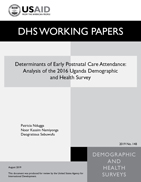There is no printed copy available to order.
Abstract:
Background: The first two days after
childbirth present the highest risk of dying
for a mother. Providing postnatal care within
the first two days after childbirth can help
avert maternal mortality because it allows
early
detection of problems that could result in
adverse maternal health outcomes.
Unfortunately, knowledge of the uptake of
early postnatal care (EPNC), which is
imperative for informing policies aimed at
reducing maternal mortality, remains low in
Uganda. Therefore, the purpose of this study
is to investigate the determinants of early
postnatal care attendance among Ugandan women
of reproductive age.
Methods: This study was based on nationally
representative data from the
2016 Uganda Demographic and Health Survey
(UDHS). The study sample comprised 5,471
women of reproductive age 15–49 who delivered
a child in the 2 years preceding the survey.
We used logistic regression to
identify factors associated with use of early
postnatal care. Andersen’s
Behavioral Model of health services
utilization guided the selection of
independent variables.
Results: Our findings showed that 50% of
mothers used EPNC services for their most
recent delivery in the 2 years preceding the
survey. Women’s residence, education level,
religion, wealth status, marital status,
occupation, antenatal care (ANC) attendance,
place of delivery, birth
order, perceived accessibility of health
facilities, and access to mass media messages
were associated with greater use of EPNC.
Women in urban areas were more likely to use
EPNC than women in rural areas, at 63% versus
46%. Nearly two-thirds of the women with
secondary education or higher (64%) received
EPNC compared with less than half of women
with
no education (47%) and women with a primary
education (44%).Receipt of EPNC was more
common among women who attended at least four
ANC visits for their most recent birth, at
54%, versus 43% among women who did not
receive the recommended four or more ANC
visits. The percentage of women receiving
EPNC was much higher among women who
delivered at a health facility, either a
public facility (63%) or private facility
(65%), versus only 9% among women who
delivered at home. Multivariate analysis
showed that delivery at a health facility was
the most important determinant of early
postnatal care attendance. Even so, the fact
that only about two-thirds of women who
delivered at a health facility
received early postpartum care shows
substantial room for improvement.
Conclusion: To increase mothers’ use of EPNC
services and improve maternal
survival in Uganda, policies and programs
could promote and strengthen health facility
delivery and ensure that EPNC services are
provided to all women before discharge.
Interventions should target women who deliver
at home, women who attend fewer than four ANC
visits, and women with a primary education.
 Determinants of Early Postnatal Care Attendance in Uganda: Further Analysis of the 2016 Demographic and Health Survey (PDF, 723K)
Determinants of Early Postnatal Care Attendance in Uganda: Further Analysis of the 2016 Demographic and Health Survey (PDF, 723K)
